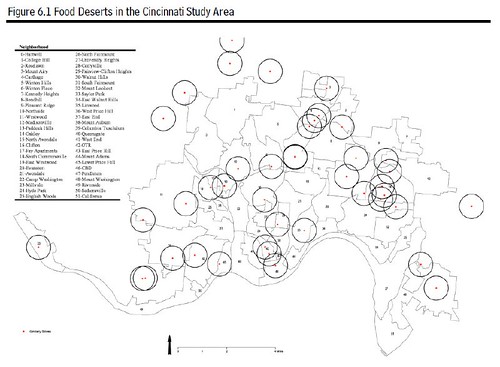For my second learning mission on EVOKE, I read a Master’s thesis entitled Cincinnati Food Security: A Community Assessment written by Brandy Jeanette McQueary at the University of Cincinnati (2008).
From the paper’s abstract:
This study investigates whether residents within the City of Cincinnati, Ohio have equal food access. For the purpose of this project, literature was reviewed from the following disciplines: international development, sociology, environmental science, urban policy, geography, planning, health, nutrition, and economics. For the purpose of this study, food access evaluates both geographic and social character. The research project establishes whether food deserts exist within Cincinnati neighborhoods, and whether a correlation exists between neighborhood social character and food insecurity.
From the paper’s first couple of chapters, I learned more about the definitions of phrases like “food security” “food deserts” “grocery gap” and other terms defined by international as well as US organizations. This helped me to better understand the research. I also learned some interesting facts about food production and security in the US:
- In the US, just 10 companies supply more than half of the food and drink consumed in this country.
- Farmers account for less than 1% of the US population.
- Food travels 2,000 miles on average from farm to plate in the US.
- Inner-city shoppers sometimes pay as much as 40% more for basic grocery items than suburban shoppers.
- Food production and delivery systems are often not considered or accounted for in urban planning models.
While I was aware that food production and distribution chains have consolidated tremendously in the last few decades, I didn’t realize just how much! And it was disturbing to discover how vulnerable inner-city populations are to food insecurity, and that urban planning often fails to address food system needs at all. Food is so basic to community sustainability (obviously!), it is shocking to realize that city planners don’t even take it into account!
After the introductory information about the topic and laying out the terms and definitions to be used for the study, the paper continued with its primary objectives, to identify all the grocery facilities in the Cincinnati metro area, defined as fifty-two Cincinnati neighborhoods, and to identify if there were “food deserts” in Cincinnati. A grocery store was considered to have a service area of 1/2 mile radius around the store, since that is the distance a healthy person could walk within 15 minutes to reach the store.
Based on McQueary’s survey of grocery stores in the Cincinnati area, I learned:
- Cincinnati is home to 165 grocery stores – 91 supermarkets, and 74 convenience stores.
- Of the 52 neighborhoods in Cincinnati, not one is completely food secure.
- 31 neighborhoods do not have a single grocery store within their boundaries.
And significant portions of the Cincinnati metro area could be defined as a “food desert” as indicated in this graphic (all areas outside the circles):

Based on this research, it appears that Cincinnati is not nearly as “food secure” as I would have thought, for being such a large metropolitan area surrounded by extensive farmland in Ohio, Indiana, and Kentucky. These findings are quite disturbing!
My mom and I have talked about finding out if a community garden exists in our neighborhood, and if not, maybe we should start one, and this research just reminds me that we need to get moving on that.   Mom, are you reading this? Call me!